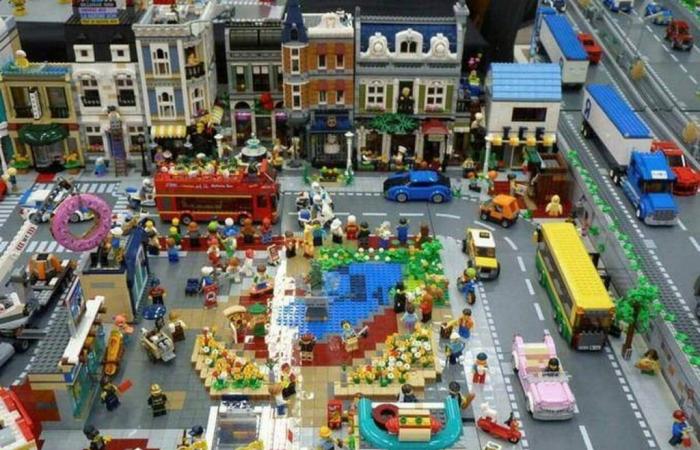By Julian ALVAREZ, associate professor at the University of Lille, Doctor in Information and Communication Sciences, University of Lille.
You may be one of the adults who plays Lego® to unwind: the brand with small plastic bricks is indeed offering an increasingly extensive offering for older children. We explain to you the reasons for this craze.
In 2023, Lego® reported 8.8 billion euros in turnover. If we consider that the international toy market was worth 168 billion euros in 2023, this represented approximately 5.25% market share. In part, this success can be explained by the diversification that the Danish brand has been able to achieve by producing video games (Lego Star Wars, Lego Batman, etc.), films (The Lego Movie, etc.), television shows (Lego Masters, etc.) , etc.
While parents may buy Lego® for their children out of nostalgia, some adults consume it for personal use. Thus, in 2021, 20% of adults bought small plastic bricks. To support this demand, the brand now offers boxes aimed at audiences 18+, with the “Lego Architecture” collection offering to reproduce monuments such as the Colosseum in Rome, Notre-Dame de Paris, “Icons” with the Eiffel Tower, the Titanic, the Artemis rocket, the Concorde, or even vintage objects like a radio from the 50s, a Pac-Man arcade machine.
Read also: Why are Lego toys still so successful almost a century after their creation?
A connection with puzzles?
Is this such a surprising phenomenon? Assembling plastic bricks to reproduce a model ultimately amounts to doing a puzzle. When we know that classic puzzle boxes with more than 1,000 pieces are generally aimed at adults, why would it be any different for Lego®? This relationship with puzzles is found on several levels, such as the display of the number of pieces on each Lego® box intended for ages 18+. For example, the “World Map” box has 11,695 pieces. From the “Lego Art” series, it is currently the item with the most bricks. “World Map” also allows you to reproduce a world map in outline mode. Once the reproduction is finished, it is also possible to frame it and hang it on the wall as some “puzzlers” can do.
Read also: The world’s puzzle champions face off, here’s how they will be decided
But with Lego®, explanatory notes are provided to follow the different steps step by step. However, the puzzle involves getting lost in the twists and turns of an image, its different shades of color, positioning pieces based on their different shapes, to try little by little to reproduce the model presented. With “World Map”, it is undoubtedly a way to relax through repetitive tasks. Indeed, this reference offers via a QR code access to a soundtrack composed of traveler testimonies to listen to while creating the world map.
The licensing phenomenon
With other models, like the Eiffel Tower or the Colosseum in Rome for example, we move into 3-dimensional puzzles. The challenge gets tougher: you have to use mental rotation to fit the bricks in the right places. The perception of the game is ultimately a subjective matter. Once the model is finished, there are two possibilities: disassemble it and put all the parts back in the box or keep it intact and why not display it. Another lever then comes into play: the collection.
Lego® offers a number of licenses such as Star Wars, the oldest. Launched in 1999, it is also the most prolific. To date, it has nearly 950 references and more than 1400 figurines. This diversity leads many passionate adults to display such objects at home or on social networks. Among the many French-speaking associations bringing together Lego® players, some specialize in the Star Wars license. This allows the thousand members to share their collections. At the same time, Lego® loyalty goes as far as offering VIP customers figurines or other exclusive products to establish this collection dynamic. Everything is supported by influencers who share news around Lego® and its new references.
Note that some buyers carefully keep the different boxes of the Star Wars license without ever opening them. This involves speculating on the rise in prices when certain references become unavailable for sale. Studies show that rates of return can reach 11%. Which is more lucrative than betting on the price of gold. Lego® does not hesitate to play on this register with its “ultimate collector series” range to signify the rarity of the product. Which allows the Danish company to justify high prices for such references.
Read also: Quiz. Are you knowledgeable about the Star Wars saga?
Proust’s madeleines effect
If we put aside the speculative aspects, combining the Star Wars and Lego® licenses makes it possible to summon two Proust madeleines simultaneously. This results in a strengthening of purchasing dynamics for both brands. In addition to the dioramas which offer to reconstruct cult scenes from the different films, there are the Lego Star Wars video games. Six titles produced between 2005 and 2022 offer an interactive replay of the different episodes of the Hollywood space opera. Players can embody different Lego® figurines bearing the likeness of characters from the saga who take place in settings and machines, the vast majority of which are references available in the catalog.
Cumulative sales of these different video game titles total just over 45 million copies worldwide. Players include both children and adults. Thus, we can see through such video games a way of extending the activity of playing Lego® to children. Such a transition is strategic on at least two points. First, from the age of 8, an Ofcom report indicates that screen consumption and video games become a predominant activity among children. Which can result in abandoning traditional toys in favor of digital games. By deploying digital games, Lego® makes it possible to support children’s playful transitions.
Read also: At what age do you really stop being a child?
Another strategic aspect lies in making children aware of the brand. Indeed, being exposed to a brand during childhood, particularly before the age of 16, would have a strong chance of resulting in loyalty in adulthood. In a context where several countries, including Denmark in particular, regulate or even prohibit advertising aimed at children for ethical reasons, the manufacturer must find other ways to promote its products and its brand while remaining within a legal framework.
In this regard, making parents prescribers of the brand can prove to be an asset. This is why Lego® marketing promotes family activities as illustrated, for example, by the Lego Play Well study which highlights the benefits of playing with bricks, particularly in terms of learning. The use of licenses such as Star Wars, but also Harry Potter, Marvel Super Heroes, Disney, Jurassic World, Indiana Jones, etc., play the role of catalysts to encourage parents’ entry via the nostalgic fiber. They can share with their little ones childhood memories linked to Lego® games and the pleasures associated with the stories carried by the different cinematographic licenses.
The creative dimension
If it is possible to create freely from any set of bricks, the Danish company also offers the “Lego Classic” range to support the approach. These packs highlight various pieces and some illustrations of possible creations as sources of inspiration. Lego® stores also offer places to sit and freely use loose bricks. Children and adults can give free rein to their imagination by creating their own models. Some enthusiasts join associations, or even register for Lego Masters. In this television show, it is about creating new models in pairs with directives and themes, within a given time: for example producing a flying machine which will make the most beautiful colored explosion when crashing to the ground.
Creativity is a powerful lever of engagement that we find in corporate co-design activities. The idea being to invite employees to propose ideas to spark innovation or resolve complex situations (problem solving, strategic development, etc.) by pooling approaches and experiences from different profiles: this is “Design Thinking”.
Lego® bricks can be used in this register. Thus, the Lego Serious Play program has been offering Lego® methods since 2002 as part of seminars involving Team Building, Hackathons and even training. Using Lego® at work certainly allows adults to re-appropriate plastic bricks through productive uses.
At the same time, Lego® seeks to promote its fans with regard to its creativity. Indeed, the lack of recognition could be a source of frustration. This is probably why the Danish company offers a program called “Lego Idea”. The community aims to propose model ideas to Danish society. If proposals receive 10,000 supports, then they are studied to potentially make them a marketed reference.
Another creative lever also comes from video games. Minecraft is one of the best-selling video game titles in the world with more than 300 million copies sold between 2009 and 2023. Using blocks that the player must make, this title allows you to build lots of elements in an environment virtual which can open up to multiplayer.
Minecraft has succeeded in transposing the creative pleasure experienced with Lego® constructions into the video game sector, and the two brands joined forces in 2012 with the first Lego Minecraft references, a license that continues to develop, originating from the Lego community Idea.
Read also: The video game imagined by these two young Bretons is a hit with thousands of enthusiasts
A profitable strategy
Relaxation, collection, nostalgia, speculation and creativity are levers of engagement on which Lego® relies. The Danish company is playing skillfully on the marketing level to continue to expand its market share by targeting families and adults in particular.
The idea is to make adults prescribers of the brand. The association of licenses from the film and video game industries aims to strengthen intergenerational exchanges. At the same time, adults offer the advantage of greater purchasing power than children. Economic aspect that Lego® has clearly identified in view of the higher prices offered by references for adults. Currently, the adult market is undoubtedly becoming one of the main levers of economic growth for Lego®: David Beckham, who shows himself on social networks playing Lego® seems to prove this hypothesis.
The original version of this article was published in The Conversation.







